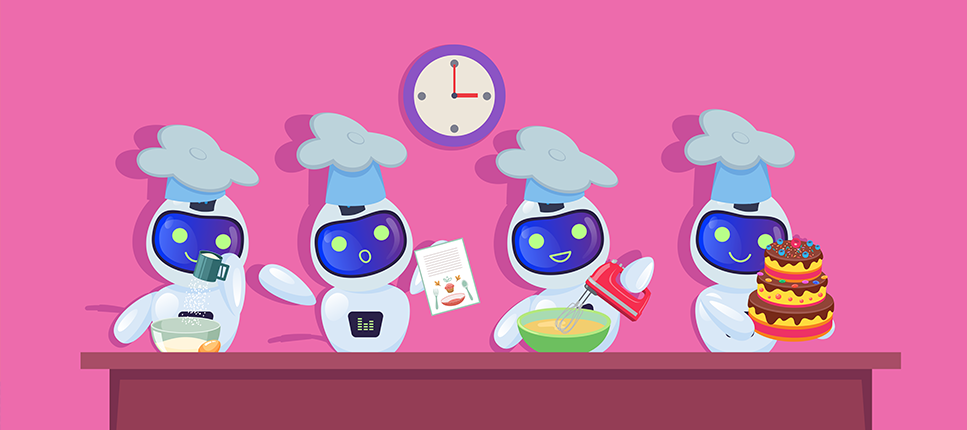In a world where the boundaries of knowledge are constantly expanding, staying ahead of the curve is not just an option, it’s a necessity.
Delve into the fascinating intersection of educational technologies, workplace transformation, upskilling, reskilling, neuroscience, artificial intelligence, virtual reality, and the vast universe of learning.
What AI can’t do (yet)
The performance of generative artificial intelligence (AI), which the general public has been discovering since the release of ChatGPT, is impressive, and not a week goes by without the appearance of new tools using this technology. Based on training data and thanks to a hyper-powerful mathematical system, generative AI can understand a complex query and statistically predict the best possible response, whether this involves solving a mathematical or scientific problem, coding, or producing text, image, audio or video. While AI experts predict it could surpass us on several fronts in the coming years or decades, it currently lacks some of the skills needed to compete with us on every cognitive terrain.
Teaching business ethics through interactive moral dilemmas
An engagement component is an element added to an online course to increase learner engagement. These are created by adapting university-level course material into engaging multimedia formats to augment the course offering. These components can allow students the opportunity to explore course concepts through a perspective not offered by traditional learning methods.
Artificial Intelligence: Test Your Knowledge!
Do you know what kind of artificial intelligence (AI) lies behind ChatGPT? Did you ever think that you could understand AI by comparing its components to those involved in making a cake? Do you have any idea what inspired the development of the branch of AI known as deep learning, which has led to current innovations in the field? Do you know what is increasingly characterizing applications such as ChatGPT? Test your knowledge by answering the following five questions.
10 categories of generative AI tools
ChatGPT is undoubtedly the best-known generative artificial intelligence (AI) tool, but it's far from the only one... The number of applications powered by this form of AI and accessible to the general public continues to multiply. Using algorithms and big data, this type of AI can generate original content - be it text, image, audio or video - in response to user requests.
The Benefits of Interactive Branching Scenarios
Educational Technologists use branching scenarios to provide learners with an immersive narrative experience that embodies learning concepts and allows them to make impactful decisions on how the learning journey plays out. This has some key advantages over more traditional, passive ways of learning, such as promoting learner engagement, allowing better retention, giving immediate...
The “Micro” Trend in Learning: Test Your Knowledge!
In the world of training, the prefix "micro," for "very small," is all the rage. You may have heard of micro modules, micro-credentials or microdiplomas. Shorter generally means more flexible, more attractive, less time-consuming, more economical... So, concepts that put the "micro" in the spotlight are emerging to better respond to new realities, including the need for continuous learning. But in the midst of all this confusion, it can be hard to find your way around. Do you know exactly what microlearning is? Are you familiar with the concept of micro-credentials? Do badges ring a bell? Test your knowledge and find out by answering the following five questions.
10 Ways Online Learning is Reshaping Companies’ Training Strategies
In the ever-evolving business landscape, training is a ubiquitous requirement for staying ahead of the competition. Especially pushed upfront by the recent pandemic, online learning has become quintessential to any company's training strategy. So, let's delve into how online learning is reshaping the corporate world, from onboarding to upskilling, fostering innovation, and enhancing employee engagement.
Simplifying AI…and Making Cakes
Artificial Intelligence is one of the buzz concepts of the last few years and its growing complexity makes it sometimes hard to wrap one’s head around. In simpler terms, it's about creating programs and systems that can make decisions, solve problems, and even recognize patterns on their own, without being explicitly programmed for. AI helps computers perform tasks that typically require human intelligence, like understanding language, recognizing objects in images, playing games, use patterns and trends within vast amounts of data to make predictions, and much more. To strip it down to its main stages, AI is like making a cake: you gather ingredients, follow a recipe, mix things together, bake it, and then you watch the results unfold.
Micro-credentials and Badges: Two Distinct Concepts
Short online training courses are gaining popularity, particularly among those wishing to acquire specific skills to add value to their professional CV. In this frenzy of new terms and concepts, some are misunderstood and sometimes confused. Such is the case with micro-credentials and badges. Let's take a closer look at what distinguishes these two concepts and why it's essential to understand their differences.
Deciphering ChatGPT
Since its release in November 2022, ChatGPT has been the talk of the town... digitally speaking. Developed by American company OpenAI, this "generative pre-trained transformer (GPT)" in the form of a conversational interface is considered the most powerful of its kind. Powered by the most sophisticated form of artificial intelligence, it surprises, amazes and worries with its performance in "cognitive" tasks that until now could only be performed by a human brain. While some see it as a revolutionary technology, it is clear that its accessibility to the general public raises major issues, particularly in terms of security and ethics. Here are a few notes to help you decipher it.










